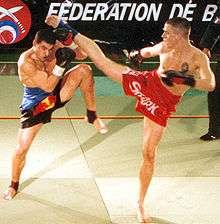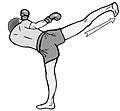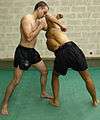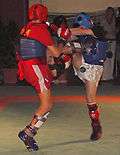Lethwei
 | |
| Also known as | Burmese Boxing |
|---|---|
| Focus | Striking |
| Hardness | Full-contact |
| Country of origin |
|
| Famous practitioners | Kyar Ba Nyein, Lone Chaw, Nilar Win, Phyan Thwe, Saw Shark, Soe Lin Oo, Too Too, Tun Tun Min, Tway Ma Shaung, U Bo Sein, U Pyi Kyaw |
| Olympic sport | No |
Lethwei (Burmese: လက်ဝှေ့; IPA: [lɛʔ.ʍḛ]) is an unarmed Burmese martial art.[1][2][3] It is similar to related styles of Indochinese kickboxing, namely Muay Thai from Thailand, Pradal Serey from Cambodia, Muay Lao from Laos and Tomoi from Malaysia.
History
In ancient times, matches were held for entertainment and were popular with every strata of society. Participation was opened to any male, whether king or commoner. At that time, matches took place in sandpits instead of rings.[4] Boxers fought without protective equipment, only wrapping their hands in hemp or gauze. There were no draws and no point system—the fight went on until one of the participants was knocked out or could no longer continue. Back then, Burmese boxing champions would enter the ring and call for open challenges.[5]>
Kyar Ba Nyein, who participated in boxing at the 1952 Summer Olympics, pioneered modern lethwei by setting in place modern rules and regulations.[6] He travelled around Myanmar, especially the Mon and Karen states, where many of the villagers still actively practiced Lethwei. Kyar Ba Nyein brought them back to Mandalay and Rangoon and, after training with them, encouraged them to compete in the matches he organized.[7]
The Myanmar government made some organizational changes to make Burmese boxing more marketable internationally.[8][9] There are a number of Burmese boxers who do compete in Thailand professionally with varying degrees of success.[10][11]
 The lai ka or "fight-dance"
The lai ka or "fight-dance" Let Khamonghkhat
Let Khamonghkhat Slapping the palm three times to the right elbow
Slapping the palm three times to the right elbow Back kick
Back kick
The first lethwei championship tournament was held in 2000. In ordinary matches there is no scoring system, but it was adopted then. The official title matches have not been held since the championship so those who knocked out the tournament winners are considered the unofficial champions. Although only two or three official events are held by the government each year, unofficial matches take place at festivals around the country every month. In government-sponsored fights, both competitors are given belts as commemorative gifts. The winners are given black-coloured belts, and the losers are given white-coloured belts.
The first international lethwei event was held in June 2001 when three kickboxers from the USA competed against lethwei practitioners. They were Shannon Ritch, Albert Ramirez and Doug Evans. All three Americans were knocked out in the first round. The second of these events took place on July 10–11, 2004 when four Japanese fighters were offered to fight against Burmese boxers. They were Akitoshi Tamura, Yoshitaro Niimi, Takeharu Yamamoto and Naruji Wakasugi. Tamura, a mixed martial artist, knocked out Aya Bo Sein in the second round and became the first foreigner to beat a lethwei practitioner in an official match.
Techniques
Aside from punches, kicks, elbows and knee attacks, Burmese boxers also make use of head-butts, raking knuckle strikes and take downs.
 spinning elbow strike
spinning elbow strike roundhouse kick
roundhouse kick knee and elbow strike
knee and elbow strike knee and punch
knee and punch jumping knee and elbow
jumping knee and elbow back hook kick
back hook kick
Rules
Matches today are carried out in both the traditional manner and a more modern offshoot called "Myanma traditional boxing", which started in 1996.[7] The latter was based on the sporting outlook of Muay Thai and uses a point system. If a knockout occurs, the boxer is revived and has the option of continuing the bout. In traditional fights, the winner is the first to draw blood which may be wiped away three times before victory is declared.

Traditional matches include 'fight for the flag' tournaments, which are still fought throughout Myanmar, especially during holidays or celebration festivals like Thingyan.[12][13]The lifeblood of traditional Lethwei rests in the rural communities where the ancient rules and tactics can still be witnessed during festivals and holidays.[14]
See also
- Burmese martial arts or Thaing (burmese)
- Bando
- Banshay
- Naban
- Pongyi thaing
- Muay Lao
- Muay Thai
- Pradal Serey
- Tomoi
References
- ↑ Kyaw Zin Hlaing (1 September 2015). "Easy win for Lethwei fighters". Myanmar Times.
- ↑ Goyder, James (22 July 2015). "Inside a Burmese Lethwei Gym". Fightland Blog (Vice).
- ↑ "Myanmese women show fighting spirit by embracing brutal martial art of Lethwei". South China Morning Post. 19 August 2015.
- ↑ Giordano, Vincent. "Born Warriors: Fighting for Survival". 15 July 2015.
- ↑ Journal of the Royal Society of Arts, Volume 41. G. Bell and Sons. 1893. p. 151.
At a Burmese boxing match a champion will jump into the ring and dance about, smacking his breast and arms and cracking his fingers, challenging all comers.
- ↑ "Kyar ba nyein". Scribd.com. Retrieved 2015-03-04.
- 1 2 Giordano, Vincent. "Born Warriors Redux: A New Era Begins for an Ancient Sport". Retrieved 15 July 2015.
- ↑ Goyder, James (17 December 2014). "The Burmese Kickboxing Style of Lethwei Expands Into Singapore". Fightland Blog (Vice).
- ↑ Giordano, Vincent. "13 August 2015 Burmese Lethwei: Bare Knuckle Revival".
- ↑ Looi, Florence (8 September 2015). "Myanmar's Lethwei fighters bare their knuckles". Al Jazeera.
- ↑ Calderon, Justin (23 September 2014). "Punches, headbutts, knockouts: Asia's 'new' martial arts sensation". CNN.
- ↑ Giordano, Vincent. "Burmese Lethwei: The Tradition of Child Fighters". Retrieved 2 September 2015.
- ↑ "Women join in Myanmar's ferocious kickboxing (with photos) | Bangkok Post: learning". Bangkokpost.com. Retrieved 2016-04-01.
- ↑ Xegarra, Guillermo. "Born Warriors: Documentarian Vincent Giordano Interview Part 2".
Further reading
- Maung Gyi, Burmese bando boxing, Ed. R.Maxwell, Baltimore, 1978
- Zoran Rebac, Traditional Burmese boxing, Ed. Paladin Press, Boulder, 2003
| Wikimedia Commons has media related to Lethwei. |